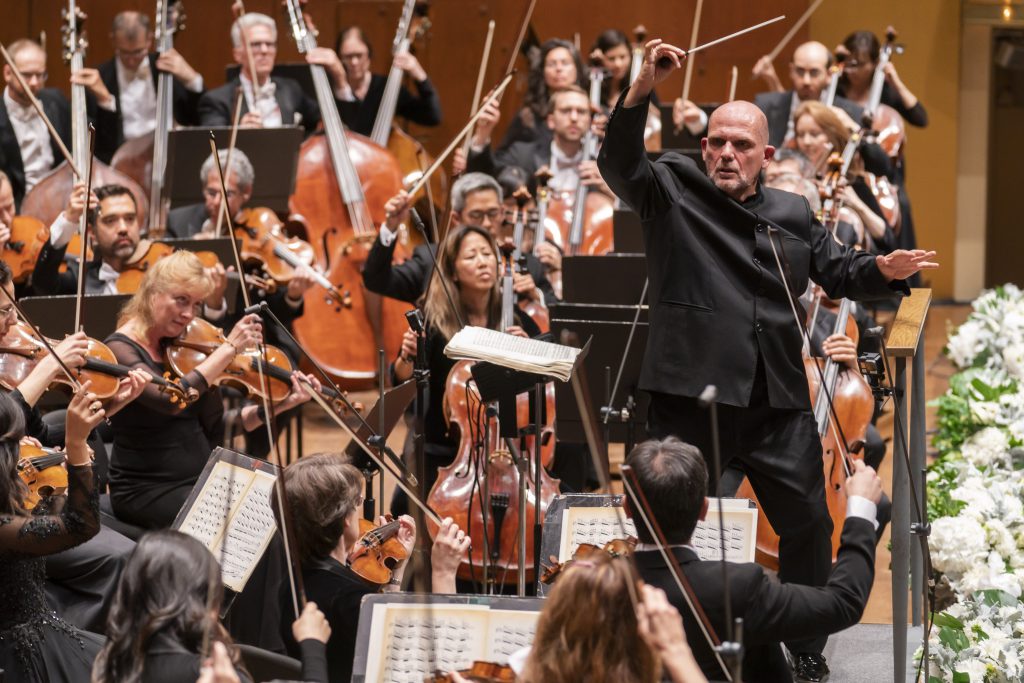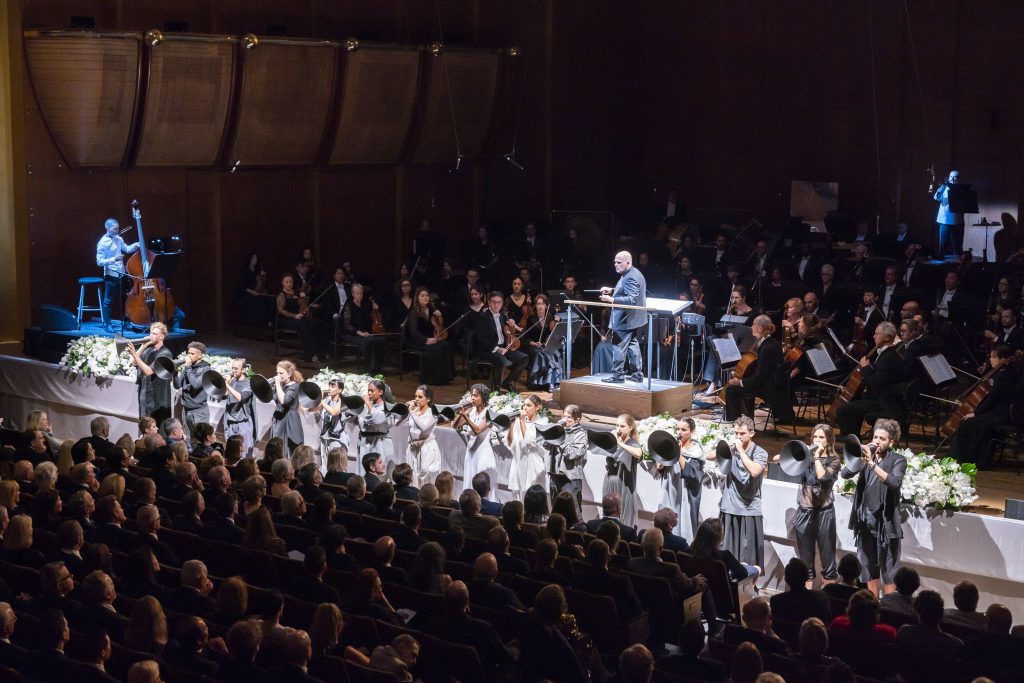Van Zweden opens Philharmonic tenure with feel-good premiere, spectacular Stravinsky

Jaap van Zweden conducted the New York Philharmonic in his inaiugural program as music director of the orchestra. Photo: Chris Lee
It seems that if the New York Philharmonic’s new music director Jaap van Zweden had his way, we would insert a hyphen in this sentence between “new” and “music.”
The incoming maestro led Thursday’s opening gala performance and Friday’s first subscription concert of the season with the world premiere of Filament by Ashley Fure, an ambitious piece of music, lighting design and stagecraft that deployed instrumentalists and singers onstage and in the aisles of David Geffen Hall. More premieres and mini-festivals about present-day composers are on the new season’s calendar.
But in Friday’s performance, the most radical-sounding music on the program was composed 105 years ago. Following Fure’s intriguing sonic experiment and a lackluster run-through of Beethoven’s “Emperor” Concerto (with a disengaged-sounding Daniil Trifonov as soloist), it was Stravinsky’s The Rite of Spring—grinding dissonances, slashing syncopations and all—that shocked one’s ears awake.
Tasked with writing the first bars of music not only of a new season, but that this music director would lead with his orchestra, Fure aimed for a kind of communal celebration, bringing musicians out among the audience. The Philharmonic itself stayed put onstage, but three soloists—trumpeter Nate Wooley, double bassist Brandon Lopez, and bassoonist Rebekah Heller—were widely stationed around the stage and the hall, and members of the Constellation Chor prowled the aisles, vocalizing in various directions through distinctively-shaped megaphones.

Photo: Chris Lee
Fure’s score assembled itself from a few clicks and hisses—analogous, perhaps, to Stravinsky’s awakening Russian landscape—to a thickly layered sound collage. Geffen Hall, with its conventionally straight rows and aisles, didn’t lend itself to free movement around the room, but the singers were at least able, using their megaphones, to “call out to each other across the void,” as the composer put it in a program note.
However, her larger goal of “sound whose angles and arrays shift around the audience” was compromised by liberal use of amplification, so that—at least to a listener downstairs and midway back–the boosted sound often seemed to come from everywhere and nowhere. The sensation was less like a live orchestra performance than like hearing a soundtrack in a movie theater.
A raft of designers were credited with the production’s visual side. César Alvarez and Lilleth Glimcher moved the singers around and clustered them for the piece’s climactic moments. Marika Kent kept the spotlight on chorus and soloists and trained some really bright lights in the audience’s eyes occasionally. Tolulope Aremu dressed the singers in a variety of T-shirts, pants and long dresses in muted colors. And apparently it took three people—Brandon Clifford, Wes McGee, and Johanna Lobdell–to design the singers’ distinctive curving megaphones, if that’s what a “matter designer” does.
By the piece’s whispering close, the consensus was that composer Fure had answered the call, and well. She came onstage to acknowledge warm applause from the audience, which called her back to the stage twice more.
Pianist Daniil Trifonov has a shy, retiring manner onstage, which is fine as long as what comes out of the instrument has some impact and authority. On Friday, in the opening piano flourishes of the “Emperor” Concerto, Trifonov sounded less like a virtuoso taking charge than a pupil dutifully executing a difficult passage, and things improved only marginally after that.
The pianist’s agility and buttery legatos were wonders to behold, but his tone didn’t project well, and so didn’t command attention. The orchestra’s attention seemed to wander as well, as it plodded routinely through the tutti sections. Taking the theme in the Adagio, the woodwinds were so far behind the piano’s accompaniment that it sounded like one of those rhythmically-offset passages Beethoven sometimes wrote intentionally, but not in this case.
At last, the Allegro ma non troppo finale elicited some energy and engagement from soloist and orchestra, although, as often happens, they ignored Beethoven’s warning and rushed the theme.
For the record, most of the audience disagreed with this listener about the performance, leaping to their feet and calling the pianist back several times. He responded with an encore, the last movement of Beethoven’s E-flat major Sonata, Op. 31, No. 3, exaggerating its quirky humor for effect. But at least, in this case, there was an effect.
The sound of curling woodwind tendrils at the start of The Rite of Spring promised a more focused and imaginative performance than the one preceding it, and van Zweden and the orchestra delivered exactly that. If this version seemed to opt a little more for control than for frenzy, it was still a relief to hear this band playing with the power and precision it was capable of, exulting in Stravinsky’s ever-changing rhythms.
Tonally, van Zweden didn’t hold his horses. Piccolo squealed, brass roared, and percussion whacked with abandon in a symphonic spectacular, no amplification necessary. (The brass in particular served up a reminder that Lincoln Center is on Broadway.) More subtle episodes of muted strings and woodwind coloration were also well looked after.
The audience’s mixed response was a tribute to Stravinsky’s continuing power to turn people off as well as on. The conductor dashed back onstage for a festive encore, Wagner’s “Ride of the Valkyries.” The audience applauded with delight when the trombones kicked in.
The program will be repeated Saturday at 8 p.m. and Tuesday at 7:30 p.m. nyphil.org; 212-875-5656.


